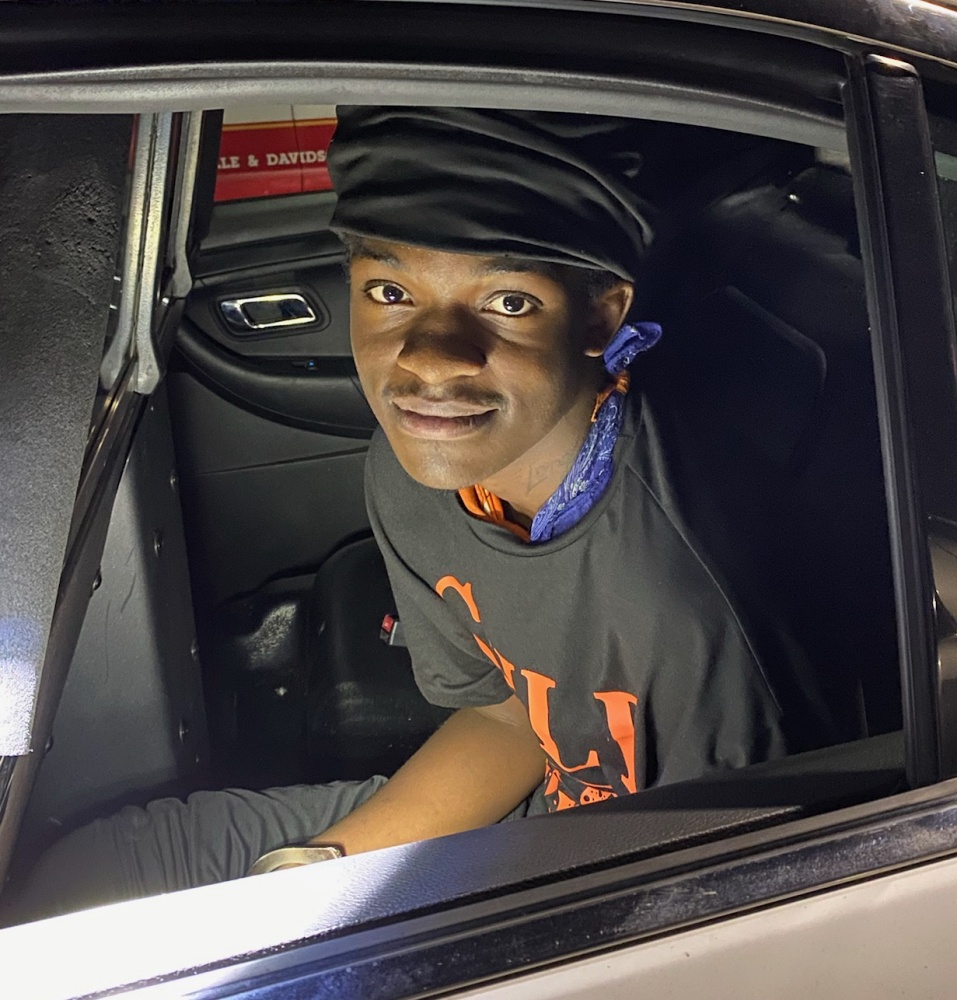Emmanuel is an asshole.
This is wonderful. I would watch 9 seasons of this. pic.twitter.com/2THHxyqKJo
— Nature is Amazing ☘️ (@AMAZlNGNATURE) May 29, 2024
Is anybody surprised?
Nope.
I am guessing the Senate will try and cook some law to stop him and it will be bipartisan.
But my money is in some fatal flaw of the Secret Service protection detail and the resulting consequences in the months to come.
If I were Trump, I would not drive by any book repository in the near or medium future.
Remembering the Past

On May 22nd, I made the trip to The Fort at No. 4 in Charlestown NH to be a part of the Rendezvous being held there. I was lucky enough to be one of the people inside the fort, and so was afforded the luxury of a rope bed, a roof, and a hearth. I spent an entire week there, with minimal electricity and running water, no showers, and only the food I brought with me. It was a very educational experience, one which I will cherish for a long time coming.
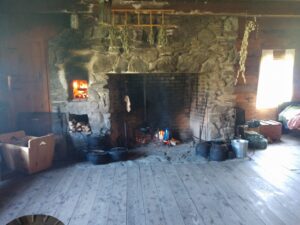
Ostensibly, my reason for going was to do some research about the 18th century in New England. I wanted to learn how to bake in a beehive oven, and many of the buildings in the fort have small beehive ovens in the side or back of their fireplaces, and so I knew I could practice as much as I wanted. I ended up teaching several classes of fourth and fifth graders, and a few homeschoolers, as well as the public who came to visit the fort over the weekend.
On Monday, Memorial Day, I made the trek down to the Rendezvous camp in the morning, to be a part of the Memorial Day celebration that was done. There were prayers said, both Christian and Native, and somber words were spoken. Names were called out, family members who had lost their lives fighting for this country. One of the women, the camp crier, reminded us all of the women who were left behind when their men died… something that is bit less of a problem today, but was horrific during the 18th and 19th centuries. We had a few minutes of silence, and then everyone quietly wended their way back to their own camps.
Later in the evening, people were back to being joyous and rambunctious, but I appreciated that pause.
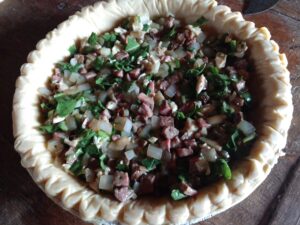
The pause had a different effect on me, being there, than it does when I am at home. It was somehow more personal. I gained a sense of what the men and women of the French and Indian war, the Revolutionary war, and the Civil war might have experienced. It was sobering.
By that Monday, I had been on site and living “the old way” for five days, and I found that I was in a comfortable routine that allowed me to get everything done without rushing. It’s amazing how much time our phones and computers and daily electronic devices take up. Cutting them out of my day left me with much time for sewing, conversing with friends, writing, and just thinking.
I ate well. I ate almost everything I had with me, too, because I brought a very specific amount of food that would force me to use my leftovers. I made myself think like a colonial, to really immerse myself in that way of life, that change of mindset. There was no junk food, no soda, no frappes or sub sandwiches. I ate two to three meals a day, as much as I needed to keep me moving and energized.
One thing I did not give up was coffee. While it is not likely that someone of my station (a woman in the 1750s whose husband was a woodsman and trapper) would have had access to coffee, I figured that since I was in the fort, I could have traded with some of the soldiers garrisoned there.
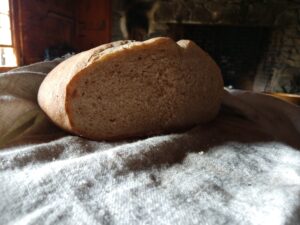
I did bake all the bread for the fort that week, a total of 10 loaves over seven days. I baked two pies, one pork and apple pie, and one minced meat and horseradish green pie. I made a pot of baked beans. All of those were made in the beehive oven, a task that heated up the (already sweltering) building. I didn’t mind. I was learning! Only my first two loaves of bread were burned. After that, they came out beautiful and brown, and full of flavor that simply can’t be gained from a modern stove.
I ate a lot of eggs, because it’s the time of year when a lot of eggs are produced. Had I lived in the fort at that time, I’d have been making butter and cheese every day as well, but since I’m not able to tolerate dairy and the fort doesn’t have any animals, I simply made one batch of butter with a school group. I had beef and chicken, and salted fish, and a big pot of pea soup which I shared with the rest of the Rendezvous during our communal dinner on Saturday evening. Oh, and I made noodles for the first time, and they turned out beautifully!
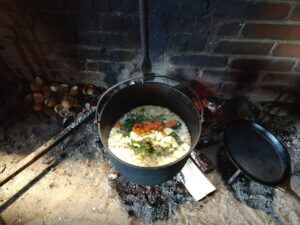
There being no showers, I was not able to clean myself as a modern person would. I heated up water each evening, and wiped myself down from head to toe. I went to the trouble of washing my hair with a bit of soap on Saturday night after I was in for the evening, as I felt it was the right thing to do, to be presentable and clean on Sunday. I admit to using a modern toothbrush and toothpaste twice a day, however, because I had no wish to have modern tooth issues.
As I puttered about, cleaning up the cabin I was in, I discovered many tools that I had never seen before. I found a pot lifter, a spit for turning meat, and a nutmeg grater (I have a modern one but this was an extant one). I got to play with a small cast iron “oil lamp” (a reservoir in the bottom for any kind of oil, with a holder up high for a cotton wick). I used the butter churn (I’ve made butter before, but never in an “old fashioned churn”). I discovered that a small, two candle tin holder with a reflective back was better at illuminating a specific area than the six candle candelabra that I had originally been using.

I think perhaps the thing that touched me the most, though, was baking the bread. It’s been many years since I baked bread from scratch, without any modern conveniences. I used a wooden bowl for mixing, a hand-carved wooden spoon for measuring out my yeast, sugar, and salt, my favorite brown coffee mug for adding in the water, and a china tea cup for measuring out flour. I stirred with a big wooden spoon until the ingredients had coalesced into the beginnings of dough, all shaggy and sticky, and then I kneaded. I started out kneading in the bowl, until most of the bits of dough clinging to the sides were caught up and incorporated into the ball I was working with. Then I turned it out onto the table, and kneaded the dough for about 30 minutes, until it was soft and elastic, and had the texture of a powdered baby’s bottom. I set the dough to rest in another bowl with a bit of oil, to keep it from sticking.
When it doubled in size I punched it down and divided into two. Each piece was kneaded briefly, and then turned into a nice, even round. I placed the two rounds onto a floured cloth inside a dough trough, and covered it up and let it rise again. Then it got sprinkled with cornmeal and the tops were slashed. Off into the beehive oven they went, to bake for 30 to 45 minutes (it does vary depending on the heat of your initial fire and your length of firing time).
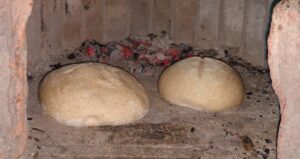
When they came out, they were steaming and beautiful, smelling incredibly delicious. I always found someone arriving about the time the bread came out. The scent wafted out my open front door, filling the central courtyard of the fort, and people followed their noses. There’s something infinitely satisfying about pulling out your bread, and putting it to cool in the window of your cabin, as people cluster around to see what it looks like.
I like writing. It’s good work, and I do it well. But the “honest work” of this past week really left me with a change in mindset. I’m trying to hold onto that peace of mind, even as I return to the bustle and fuss of the internet and television and teenagers clamoring for my attention. I learned that I can quiet my own mind, and that was a priceless gift.
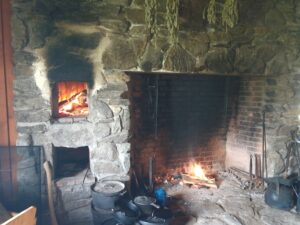
Now that I’ve finished communing with my ancestors’ past, and I’ve returned to the “real” world, I’m looking around me with new eyes. There are too many THINGS in my house. The cabin had lots of cast iron, and quite a few cooking tools that were much needed, but it wasn’t cluttered with “use once” items. I kept it very clean, so clean that when I went to pack up, it took almost no time at all. I found a great pride in keeping it clean and neat, and leaving it better than I found it. I need to find a way to do that with my own home, especially as the children become adults and fly off to their own adventures.
I hope your Memorial Day weekend (or week) was as thought provoking and peacefully contemplative as mine.
Hagar,
who is quietly thoughtful.
Ladies, zip up your purse
Ladies, zip up your purse.
Gentlemen, button your pockets.
These people are everywhere.
What “Globalize the Intifada” looks like
Shooting at a Synagogue in Montreal:
??? ????????:
Multiple bullets fired at Jewish Synagogue in Montreal, Canada.
4 shots were shot through the front door of Belz Yeshiva Katana.
The gunman fled the scene in a vehicle.
No injuries reported. pic.twitter.com/m2gXvTx8mU
— Jewish Uncensored (@JewUncensored) May 30, 2024
A shooting at a Jewish girls’ day school in Toronto:
? HAPPENING NOW: Terror in Toronto as Gunmen Open Fire on Jewish Girls’ School
⚠️WATCH: “Two Men Open Fire, 5 Rounds Fired at Bais Chaya Mushka Elementary School”
? Another attack on a Jewish institution occurred today in Toronto.
The Bais Chaya Mushka Girls Elementary… pic.twitter.com/t1qvmpwbc6
— Shirion Collective (@ShirionOrg) May 25, 2024
A driver attempting to run over Jews in Brooklyn:
? BREAKING: Attempted Mass Murder of Jews in Brooklyn Hate Crime
⚠️ Muslim Maniac Screams ‘I’m Gonna Kill All the Jews’ as He Tries to Run Down Students Outside NYC Jewish School
? The Incident: On May 29, Asghar Ali, a 58-year-old Pakistani Muslim immigrant and cab driver… pic.twitter.com/dasfQbhmIE
— Shirion Collective (@ShirionOrg) May 30, 2024
Murderous violence directed at random Jews.
By the grace of God, nobody was killed.
When the Hamasniks say “globalize the Intifada” this is what they mean.
Jews need to be armed and vigilant all the time, because nowhere is safe.
The popular acceptance Antisemitism has emboldened these people to increase their violence.
Be prepared.
Massachusetts malicious compliance with Bruen
I applied to get my Massachusetts non-resident LTC to make living on the New Hampshire/Massachusetts border easier.
Today, I got my email from Massachusetts that I am scheduled for my interview for my LTC.
My interview is… in February.
That’s a long wait.


